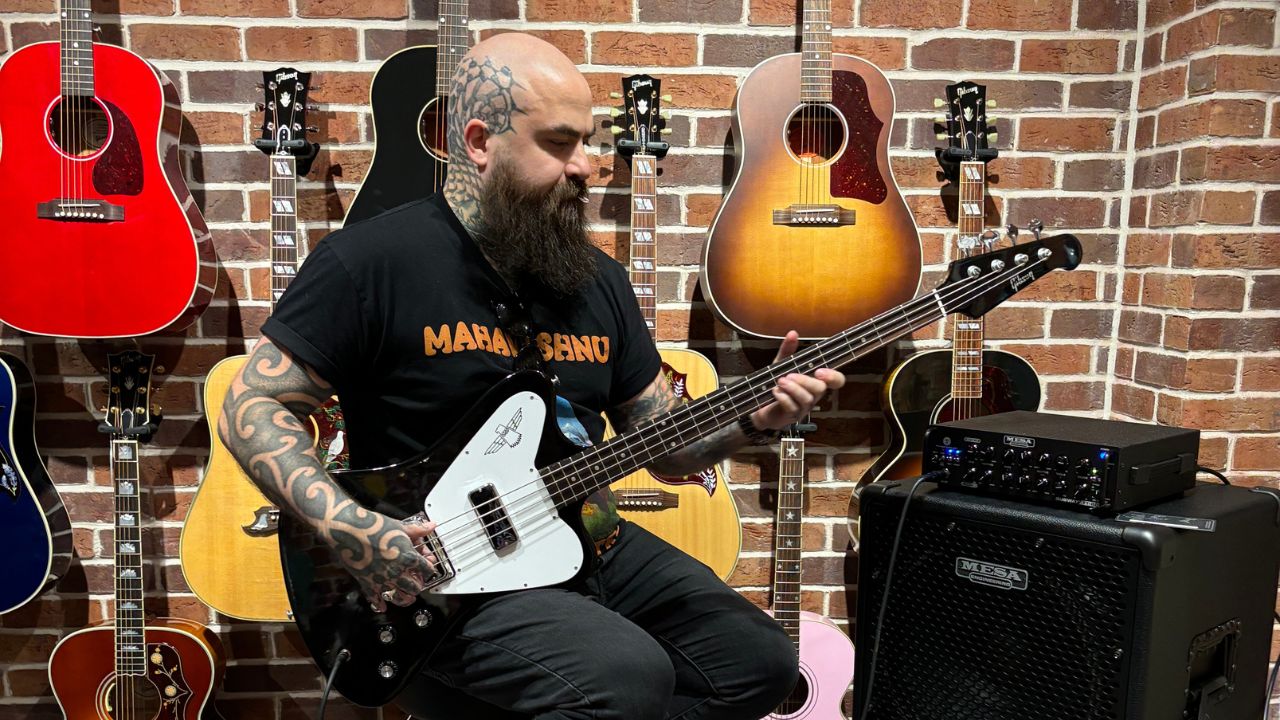“I get infuriated by people who insist I should play a 5-string”: Alex ‘V-Man’ Venturella on tone, technique – and how he nailed his Slipknot audition
Slipknot's low-end specialist discusses his epic amp collection, the brilliance of Eloy Casagrande and how James Hetfield shaped his technique

They swore. They drank. They wrote songs about decaying flesh. Straight out of the blocks, Slipknot had all the measures in place to guarantee the outrage of Iowa's retirement homes.
Fusing the bile of punk with the brutality of thrash, they recruited the cream of the town’s underground metal scene, slackening their guitar tunings down to drop B, and dabbling with a series of leather masks, ranging from a bloodstained clown to a chap with nails sticking out of his head.
Thirty years on, they are still responsible for metal's most unholy racket. With bassist Alex Venturella (otherwise known as V-Man) adding the gut-wrenching bottom end to the Slipknot sound.
In 2010, Slipknot were rocked by tragedy when their original bassist Paul Gray succumbed to an opioid overdose. Three years later, another founding member, drummer Joey Jordison, also left the band.
In this period, when the nine members were reduced to seven, Slipknot were between albums, and a new rhythm section had to be found before a new one could be recorded. Enter Alex Venturella, who was recruited in 2014.
“I think I was the last person to audition,” Venturella told Bass Player. “When I told James Leach from the band Sikth about the audition, he told me to down pick as hard as I could. So the plan was to down pick and just hit it hard!”
“I was always a fan of James Hetfield and the way he would down pick everything, especially on albums like ...And Justice For All. He had so much control over it, and I felt like that approach was very relatable to bass playing, so that’s what I was aiming for, and it’s what I’ve done with the band ever since.”
All the latest guitar news, interviews, lessons, reviews, deals and more, direct to your inbox!
What do you remember about joining Slipknot?
“I had these visions of making the bass a really prominent thing. I wasn’t just going to learn the lines and then call it a day, but it was a weird time for them.
“Paul and Joey had been the core of the band, and they were both gone. So it was like, ‘This is what Paul used, and we’d like you to keep playing like that.’
“They were still a tight unit, and I didn’t want to do anything that made them think, ‘Who the fuck is this guy?’ Luckily, they realised that setup wasn’t really my thing. That’s when the rig started to get bigger.”

What do you remember about the audition?
“They flew me out to Sunset Sound studio in L.A., and I had to plug into this Orange OD head and an 8x10 cabinet. This was my only chance to audition, so I asked if we could change some things around.
“There was a rental place across the street, so I went over and got a Mesa Boogie 400 Plus, which is one of those amps that always sounds incredible. They wanted me to jam on some new stuff, and it was cool.”
What bass guitars were you playing back then?
“The only bass I had with me was a Zon bass that Troy from Mastodon had leant me. It had this carbon neck and a super-smooth neck radius, but the producer, Greg Fidelman, was like, ‘These are the basses we want you to use.’”
“Greg had this ‘60s P-Bass with a nut that had been cut so many times that the strings were rattling around, and a pickup that couldn't really handle how hard I played. It really wasn’t up to the job, but it sounded great. So it was a case of doing my best to make it work.”
Do you prefer four or five-strings?
“I very rarely reply to comments on social media, but I get infuriated by people who insist I should play a 5-string. If I was playing a Dingwall or a multi-scale instrument, then it would make more sense. But I can use a 105 gauge string on a 4-string bass guitar and still tune it low. I get annoyed with really thick strings.”
How about your backline?
“I used a Mesa/Boogie 400 Plus for the last two records. I did mess around with different amp companies for the We Are Not Your Kind record, which was the first one coming back, but you can really push the Mesa, so I stuck with that.”
“I’ve also got an old Sano, a Mesa Boogie Quad, a Basis M-2000, a Demeter MP-11, a David Eden, and the Trace Elliot amp that Mark King used to use. My amp collection is made up of all the fun things that amp companies used to make!”
You’re a big fan of Mesa Boogie, then?
“One of those Mesa amps is like the holy grail. It has a real sweet spot. We ended up taking it on tour, but one day it just wouldn’t turn on. Mesa have an authorised repair guy, and he came back with a bunch of stuff that he suggested I fix, but he also said it would massively alter the tone.
“I told him to just get it working and leave the rest because that stuff’s where the magic is. That’s the problem with using vintage gear. You can't just go down to Guitar Center and pick up another one.”

How do you feel about digital all-in-one rigs?
Digital amps just don’t break up in the same way as valve amps. There will be some people who can’t hear the difference, but my front of house guy can, my monitor guy can, and I can!
“Digital amps just don’t break up in the same way as valve amps. There will be some people who can’t hear the difference, but my front of house guy can, my monitor guy can, and I can!
“I do own a Quad Cortex, and I use an AXE Effects live, but that’s really just for effects. So it’s in my wheelhouse, but my thing is definitely old valve amps. I just can’t get away from that world.”
What else can you tell us about your rig?
“My rig is split in two. One side is super clean and the other has all the grit. It’s just the smart way of doing it because you’re always in control. It also makes the front of house guy have a nicer day. Guys like Billy Sheehan, John Entwistle and Chris Squire all did the same thing.”
Do you ever experiment with compression?
Eloy said it was the heaviest bass sound he’d ever heard, but he could still hear everything I was doing
“I use an Origin Effects compressor, but that’s purely because the stages we play are so big, and my monitoring is a bit further back, so if I ever get to the front of the stage it becomes harder to hear. Having the compressor just stops me from disappearing in the mix. If you turn it off, you’re not going to notice a big difference. It’s just catching some of those odd transients.”
Your Status S2 is also a major part of your sound.
“My Status basses have a mid boost that I always have turned all the way up, which gives the tone an almost piano-like quality. It works really well with Eloy’s kick drum. He said it was the heaviest bass sound he’d ever heard, but he could still hear everything I was doing.”
What’s it like playing with Eloy?
“I've never played with a drummer of his calibre. When we're locked in together, everything just sounds bigger. And that gives the guitars more space. With Slipknot there’s a lot going on!”

Any other tips for getting a great bass tone?
“Look at the gear your favourite bass players are using, and go try it out. Find out if it works for you, and then just see what evolves from there. Sometimes buying a new pedal can lead to something that’s unique to you. Even a string change can be enough to change the way you play. I actually change my strings every set, but I'll use the same pick for the whole show.”
Do you always use a guitar pick?
“I’ve tried to use my fingers, but if you’re playing 16th notes really fast, I don't care how good you are, you're never going get the same ‘whack’ as you do with a pick. But learning how to play with a pick can be like learning to play a whole new instrument.”
What picks do you use?
“I used to use 0.88mm Dunlop Triangles, and then I went to 1.0mm. That made all the difference for playing live.”
- Catch the V-Man on tour with the Iowa metal institution. See Slipknot for dates and ticket details.

Nick Wells was the Editor of Bass Guitar magazine from 2009 to 2011, before making strides into the world of Artist Relations with Sheldon Dingwall and Dingwall Guitars. He's also the producer of bass-centric documentaries, Walking the Changes and Beneath the Bassline, as well as Production Manager and Artist Liaison for ScottsBassLessons. In his free time, you'll find him jumping around his bedroom to Kool & The Gang while hammering the life out of his P-Bass.
You must confirm your public display name before commenting
Please logout and then login again, you will then be prompted to enter your display name.

![Slipknot - Nero Forte [OFFICIAL VIDEO] - YouTube](https://img.youtube.com/vi/JGNqvH9ykfA/maxresdefault.jpg)

